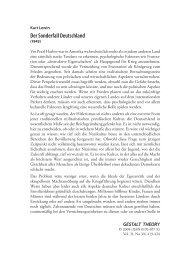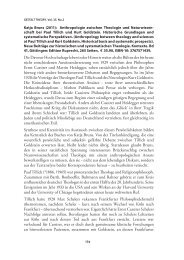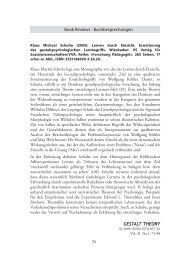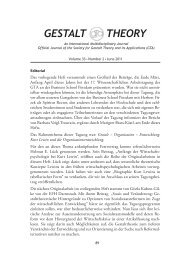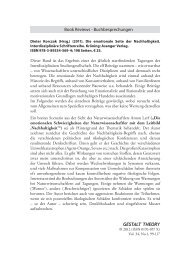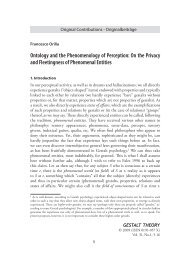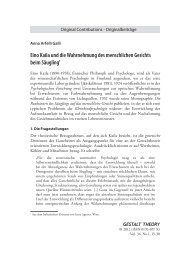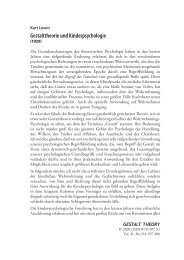What is the Meaning of Shape? - Gestalt Theory
What is the Meaning of Shape? - Gestalt Theory
What is the Meaning of Shape? - Gestalt Theory
Create successful ePaper yourself
Turn your PDF publications into a flip-book with our unique Google optimized e-Paper software.
391<br />
Pinna, <strong>What</strong> <strong>is</strong> <strong>the</strong> <strong>Meaning</strong> <strong>of</strong> <strong>Shape</strong>?<br />
3.3. The Role <strong>of</strong> <strong>the</strong> Frame <strong>of</strong> Reference in <strong>Shape</strong> Perception<br />
More recent and complex explanations <strong>of</strong> <strong>the</strong> square/diamond illusion are based<br />
on object-centered reference frames. Rock (1973, 1983; see also Clément &<br />
Bukley, 2008), starting from previous <strong>Gestalt</strong> studies (Asch & Witkin, 1948a,<br />
1948b; K<strong>of</strong>fka, 1935; Metzger, 1941, 1975), suggested that <strong>the</strong> perceived<br />
shape <strong>is</strong> a description relative to a perceptual frame <strong>of</strong> reference, i.e. <strong>the</strong> v<strong>is</strong>ual<br />
system prefers gravitational axes over retinal or head axes. In o<strong>the</strong>r words, Rock<br />
considered Mach’s square/diamond illusion as a clear evidence that a shape<br />
<strong>is</strong> perceived in relation to an environmental frame <strong>of</strong> reference where gravity<br />
defines <strong>the</strong> reference orientation, at least in <strong>the</strong> absence <strong>of</strong> intrinsic axes in <strong>the</strong><br />
object itself. If <strong>the</strong> environmental orientation <strong>of</strong> <strong>the</strong> figure changes with respect<br />
to <strong>the</strong> two figures, <strong>the</strong> description <strong>of</strong> one shape does not match <strong>the</strong> description<br />
stored in memory for <strong>the</strong> o<strong>the</strong>r shape, <strong>the</strong>refore <strong>the</strong> observer fails to perceive <strong>the</strong><br />
equivalence <strong>of</strong> <strong>the</strong> two figures.<br />
The stimulus factors important in determining <strong>the</strong> intrinsic reference frame<br />
are: gravitational orientation; directional symmetry (Pinna, 2010b; Pinna &<br />
Reeves, 2009); axes <strong>of</strong> reflectional symmetry, configural orientation (Attneave,<br />
1968; Palmer, 1980) and axes <strong>of</strong> elongation (Marr & N<strong>is</strong>hihara, 1978; Palmer,<br />
1975a, 1983, 1985; Rock, 1973). These factors rule <strong>the</strong> relation between shape<br />
and orientation as it happens in o<strong>the</strong>r phenomena (e.g., <strong>the</strong> rod-and-frame and<br />
Kopfermann’s effects; Davi & Pr<strong>of</strong>itt, 1993; Kopfermann, 1930; see also Marr &<br />
N<strong>is</strong>hihara, 1978; Palmer, 1975b, 1989, 1999; Witkins & Asch, 1948).<br />
These explanations contain some serious limits especially within <strong>the</strong> context <strong>of</strong><br />
phenomenology. More particularly, <strong>the</strong>y cannot account for <strong>the</strong> reason why we<br />
perceive a square, a diamond or a rotated square without invoking names and<br />
descriptions stored in memory. More specifically, <strong>the</strong>y do not say anything about<br />
what changes phenomenally inside <strong>the</strong> shape properties when axes <strong>of</strong> reflection,<br />
gravitation and o<strong>the</strong>r factors change and about which shape properties switch<br />
when a square switches to a diamond.<br />
These limits are accompanied by <strong>the</strong> following questions: why are two names/<br />
descriptions (square and diamond) stored so differently? Are <strong>the</strong>y stored as different<br />
names because <strong>the</strong>y are perceived differently or are <strong>the</strong>y perceived differently<br />
because <strong>the</strong>y are stored in memory with different names/descriptions? These last<br />
questions are not trivial because <strong>the</strong>y are related to <strong>the</strong> important problem <strong>of</strong><br />
<strong>the</strong> primary role <strong>of</strong> v<strong>is</strong>ual perception over <strong>the</strong> higher cognitive processes (see<br />
Kanizsa, 1980, 1985, 1991). Th<strong>is</strong> implies that <strong>the</strong> difference between square and<br />
diamond can be accounted for within <strong>the</strong> domain <strong>of</strong> v<strong>is</strong>ion alone and in terms <strong>of</strong><br />
perceptual organization <strong>of</strong> shape attributes.<br />
In addition to <strong>the</strong>se <strong>is</strong>sues, <strong>the</strong> previous hypo<strong>the</strong>ses cannot explain what shapes,<br />
such as squares, diamonds or rotated squares, are, and, even more generally, <strong>the</strong>y





